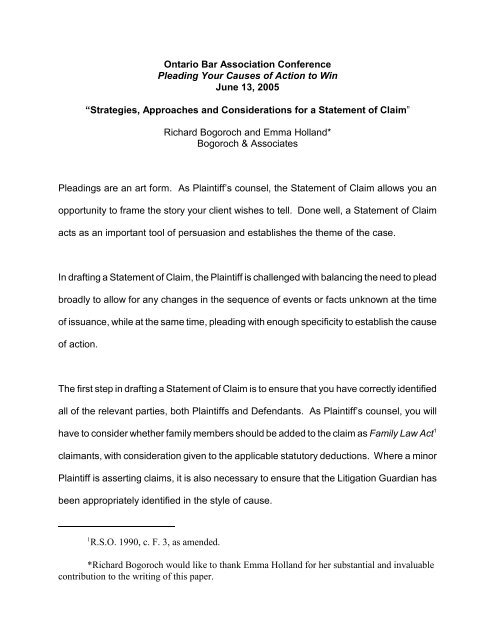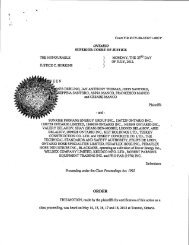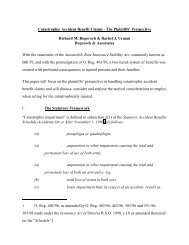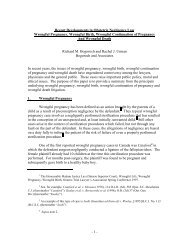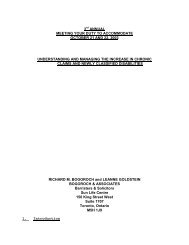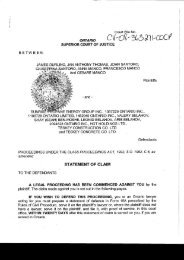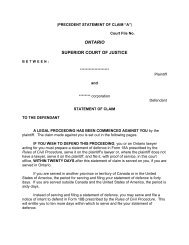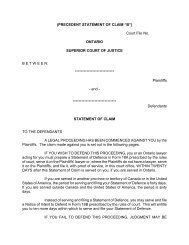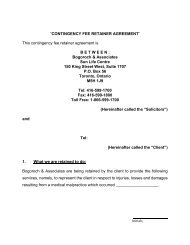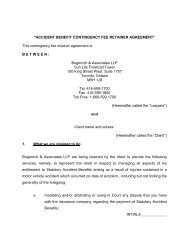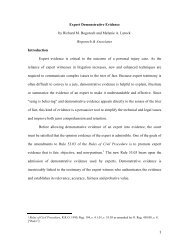Strategies, Approaches and Considerations for a Statement of Claim ...
Strategies, Approaches and Considerations for a Statement of Claim ...
Strategies, Approaches and Considerations for a Statement of Claim ...
You also want an ePaper? Increase the reach of your titles
YUMPU automatically turns print PDFs into web optimized ePapers that Google loves.
Ontario Bar Association Conference<br />
Pleading Your Causes <strong>of</strong> Action to Win<br />
June 13, 2005<br />
“<strong>Strategies</strong>, <strong>Approaches</strong> <strong>and</strong> <strong>Considerations</strong> <strong>for</strong> a <strong>Statement</strong> <strong>of</strong> <strong>Claim</strong>”<br />
Richard Bogoroch <strong>and</strong> Emma Holl<strong>and</strong>*<br />
Bogoroch & Associates<br />
Pleadings are an art <strong>for</strong>m. As Plaintiff’s counsel, the <strong>Statement</strong> <strong>of</strong> <strong>Claim</strong> allows you an<br />
opportunity to frame the story your client wishes to tell. Done well, a <strong>Statement</strong> <strong>of</strong> <strong>Claim</strong><br />
acts as an important tool <strong>of</strong> persuasion <strong>and</strong> establishes the theme <strong>of</strong> the case.<br />
In drafting a <strong>Statement</strong> <strong>of</strong> <strong>Claim</strong>, the Plaintiff is challenged with balancing the need to plead<br />
broadly to allow <strong>for</strong> any changes in the sequence <strong>of</strong> events or facts unknown at the time<br />
<strong>of</strong> issuance, while at the same time, pleading with enough specificity to establish the cause<br />
<strong>of</strong> action.<br />
The first step in drafting a <strong>Statement</strong> <strong>of</strong> <strong>Claim</strong> is to ensure that you have correctly identified<br />
all <strong>of</strong> the relevant parties, both Plaintiffs <strong>and</strong> Defendants. As Plaintiff’s counsel, you will<br />
have to consider whether family members should be added to the claim as Family Law Act 1<br />
claimants, with consideration given to the applicable statutory deductions. Where a minor<br />
Plaintiff is asserting claims, it is also necessary to ensure that the Litigation Guardian has<br />
been appropriately identified in the style <strong>of</strong> cause.<br />
1<br />
R.S.O. 1990, c. F. 3, as amended.<br />
*Richard Bogoroch would like to thank Emma Holl<strong>and</strong> <strong>for</strong> her substantial <strong>and</strong> invaluable<br />
contribution to the writing <strong>of</strong> this paper.
2<br />
In determining which parties to identify as the appropriate Defendants in an action, it is<br />
wise to err on the side <strong>of</strong> caution in naming any <strong>and</strong> all parties who may ultimately be found<br />
to be responsible <strong>for</strong> the proposed claim. Often in a medical malpractice action, the expiry<br />
<strong>of</strong> a limitation period is approaching <strong>and</strong> counsel must issue the Notice <strong>of</strong> Action <strong>and</strong>/or<br />
<strong>Statement</strong> <strong>of</strong> <strong>Claim</strong> without receiving all <strong>of</strong> the relevant documentation needed to fully<br />
investigate the claim. In such cases, it is necessary to name as Defendants all primary<br />
medical personnel who participated in the alleged negligent treatment, along with<br />
additional, yet to be identified Defendants (i.e. “Dr. John Doe” <strong>and</strong>/or “Nurse Jane Doe”).<br />
In doing so, the applicable limitation periods may be protected <strong>and</strong> the Plaintiff is able to<br />
assert the right <strong>of</strong> discovery over more parties, adverse in interest, who may be able to<br />
2<br />
<strong>of</strong>fer further insight into the alleged negligence. It is, however, essential to proceed to<br />
discovery only after an investigation has been conducted <strong>and</strong> only after counsel is in<br />
receipt <strong>of</strong> an expert report favourable to his case.<br />
In many cases, it will also be necessary to plead inconsistent allegations in order to assert<br />
multiple causes <strong>of</strong> action <strong>and</strong>/or assert the same allegations <strong>of</strong> negligence against different<br />
Defendants when responsibility <strong>for</strong> the negligence remains unclear. Pleading “in the<br />
alternative” is permitted under the Rules <strong>of</strong> Civil Procedure so long as this inconsistency<br />
is acknowledged in the <strong>Statement</strong> <strong>of</strong> <strong>Claim</strong>.” 3<br />
2<br />
Rule 31.03(1) <strong>of</strong> the Rules <strong>of</strong> Civil Procedure, R.R.O. 1990, Reg. 194, as amended.<br />
3<br />
Rule 25.06(4) <strong>of</strong> the Rules <strong>of</strong> Civil Procedure, R.R.O. 1990, Reg. 194, as amended.
3<br />
The <strong>for</strong>emost objective <strong>for</strong> any Plaintiff’s counsel in drafting a <strong>Statement</strong> <strong>of</strong> <strong>Claim</strong> is to<br />
plead the allegations in such a fashion as to permit him/herself the broadest possible rights<br />
4<br />
<strong>of</strong> discovery. As the seminal case <strong>of</strong> Kay v. Posluns in<strong>for</strong>ms us, questions on an oral<br />
discovery will be limited to those which demonstrate a “semblance <strong>of</strong> relevance” to facts<br />
<strong>and</strong> matters at issue, as defined by the pleadings. For example, questions at an<br />
Examination <strong>for</strong> Discovery regarding the repair history <strong>of</strong> a snow plough in a snow <strong>and</strong> ice<br />
motor vehicle case against a municipal road authority will likely be upheld as proper<br />
questions on a refusals motions where the Plaintiff has included an allegation concerning<br />
the fitness <strong>of</strong> the vehicles in the <strong>Statement</strong> <strong>of</strong> <strong>Claim</strong>.<br />
In addition to considerations regarding discovery rights, it is also important to be aware <strong>of</strong><br />
any weaknesses in the <strong>Statement</strong> <strong>of</strong> <strong>Claim</strong> which would make it vulnerable to attack by the<br />
Defendants. In a motion brought pursuant to Rule 21.01(1)(b) <strong>of</strong> the Rules <strong>of</strong> Civil<br />
Procedure, the Defendant will attempt to strike out the <strong>Statement</strong> <strong>of</strong> <strong>Claim</strong> on the ground<br />
5<br />
that it discloses no reasonable cause <strong>of</strong> action. While the test on this motion is strict,<br />
requiring pro<strong>of</strong> that it is plain <strong>and</strong> obvious that the claim discloses no cause <strong>of</strong> action, it is<br />
important to ensure that the necessary elements <strong>of</strong> the cause <strong>of</strong> action <strong>and</strong>/or the facts<br />
6<br />
supporting such elements are adequately addressed in the <strong>Statement</strong> <strong>of</strong> <strong>Claim</strong>. For<br />
example, in a motor vehicle accident case, it is necessary to identify the various negligent<br />
4<br />
(1989), 71 O.R. (2d) 238 (H.C.); additional reasons (February 1, 1991), Doc. No.<br />
Toronto 26686/88 (Gen. Div.).<br />
5<br />
Rule 21.01(1)(b) <strong>of</strong> the Rules <strong>of</strong> Civil Procedure, R.R.O. 1990, Reg. 194, as amended.<br />
6<br />
Hunt v. Carey Canada Inc., [1990] 2 S.C.R. 959.
4<br />
actions or/omissions on the part <strong>of</strong> the Defendant driver (i.e. made an unsafe left h<strong>and</strong><br />
turn) which resulted in injuries to the Plaintiff (i.e. struck the Plaintiff’s vehicle, causing<br />
injuries to his head, neck <strong>and</strong> arm) <strong>for</strong> which s/he is claiming damages (i.e. loss <strong>of</strong> income).<br />
A <strong>Statement</strong> <strong>of</strong> <strong>Claim</strong> must contain a concise statement <strong>of</strong> the material facts on which the<br />
Plaintiff intends to rely. However, it is also important to bear in mind that the evidence by<br />
7<br />
which those facts are to be proved must not be included in the <strong>Statement</strong> <strong>of</strong> <strong>Claim</strong>. While<br />
what constitutes “evidence” versus “material fact” may be the subject <strong>of</strong> some debate, in<br />
motor vehicle accident cases, it is <strong>of</strong>ten useful to plead any convictions entered against the<br />
Defendant arising as a result <strong>of</strong> the subject accident which are, arguably, “material facts”<br />
at issue. 8<br />
In a <strong>Statement</strong> <strong>of</strong> <strong>Claim</strong>, any point <strong>of</strong> law may be raised but conclusions <strong>of</strong> law can only<br />
9<br />
be pleaded if the material facts supporting the legal conclusion are also pleaded . The<br />
<strong>Statement</strong> <strong>of</strong> <strong>Claim</strong> should include reference to any statute <strong>and</strong> the applicable sections to<br />
10<br />
be relied upon in asserting a cause <strong>of</strong> action (i.e. the Negligence Act or the Insurance<br />
7<br />
Rule 25.06(1) <strong>of</strong> the Rules <strong>of</strong> Civil Procedure, R.R.O. 1990, Reg. 194, as amended.<br />
8<br />
Royal Bank <strong>of</strong> Canada v. McArthur et al. (1985), 51 O.R. (2d) 86; Demeter v. British<br />
Pacific Life Insurance Co. et al. (1984), 48 O.R. (2d) 266 (C.A.); (1983), 43 O.R. (2d) 33<br />
(H.C.J.).<br />
9<br />
Rule 25.06(2) <strong>of</strong> the Rules <strong>of</strong> Civil Procedure, R.R.O. 1990, Reg. 194, as amended.<br />
10<br />
R.S.O. 1990, c. N.1, as amended.
5<br />
11<br />
Act ). Where the Plaintiff intends to rely upon an out <strong>of</strong> province statute, it should be<br />
expressly pleaded with reference to the statute’s name, citation, province <strong>of</strong> origin, section<br />
12<br />
numbers <strong>and</strong> the words <strong>of</strong> the section.<br />
The appropriate relief sought in a pleading will, <strong>of</strong> course, depend on the nature <strong>of</strong> the<br />
action. The <strong>Statement</strong> <strong>of</strong> <strong>Claim</strong> must contain a claim <strong>for</strong> relief, with the nature <strong>of</strong> the relief<br />
specified, <strong>and</strong> also, where damages are claimed, an indication <strong>of</strong> the amount claimed <strong>for</strong><br />
each claimant in respect <strong>of</strong> each claim sought <strong>and</strong> the amounts <strong>and</strong> particulars <strong>of</strong> any<br />
13<br />
special damages known at the time. In a long term disability action, the Plaintiff may seek<br />
reinstatement <strong>of</strong> benefits to which they are owed <strong>and</strong> payment <strong>for</strong> all outst<strong>and</strong>ing amounts.<br />
In a motor vehicle accident, the Plaintiff will seek payment <strong>of</strong> an award <strong>for</strong> damages in an<br />
amount usually based on the maximum amount <strong>of</strong> insurance available. Where the<br />
specifics <strong>of</strong> the relief (i.e. out <strong>of</strong> pocket expenses) are unknown at the time the <strong>Statement</strong><br />
<strong>of</strong> <strong>Claim</strong> is issued, the claim may merely reflect that the particulars will be provided prior<br />
14<br />
to the trial <strong>of</strong> the action. In addition, it is also useful to include a request <strong>for</strong> “such further<br />
<strong>and</strong> other relief as the Court may deem just” to enable the Court to grant relief not pleaded<br />
11<br />
R.S.O. 1990, c. I. 8, as amended.<br />
12<br />
Boulanger v. Johnson & Johnson Corp. (2003), 64 O.R. (3d) 208 (Div. Ct.).<br />
13<br />
Rule 25.06(9) <strong>of</strong> the Rules <strong>of</strong> Civil Procedure, R.R.O. 1990, Reg. 194, as amended.<br />
14<br />
Rule 25.06(9)(b) provides that particulars as to special damages unknown at the time <strong>of</strong><br />
the issuance <strong>of</strong> the <strong>Statement</strong> <strong>of</strong> <strong>Claim</strong> must be delivered <strong>for</strong>thwith after they are known <strong>and</strong>/or<br />
not less than ten days be<strong>for</strong>e trial.
6<br />
15<br />
in the <strong>Statement</strong> <strong>of</strong> <strong>Claim</strong>.<br />
Having considered the importance <strong>of</strong> naming all potential Defendants to an action, the<br />
need to plead broadly to permit a wide scope <strong>of</strong> discovery <strong>and</strong> with enough specificity to<br />
avoid a Rule 21 motion, <strong>and</strong> the requirements under the Rules <strong>of</strong> Civil Procedure, it is also<br />
important to recognize that mistakes are made, parties are incorrectly named, <strong>and</strong><br />
allegations are missed. Fortunately, the Rules <strong>of</strong> Civil Procedure instruct Courts, on<br />
motion, to grant parties leave to amend a pleading “on such terms as are just, unless<br />
prejudice would result that could not be compensated <strong>for</strong> by costs or an adjournment.” 16<br />
The importance <strong>of</strong> the <strong>Statement</strong> <strong>of</strong> <strong>Claim</strong>, as the first introduction to the litigation, should<br />
17<br />
not be underestimated.<br />
15<br />
Eckl<strong>and</strong> v. Eckl<strong>and</strong>, [1973] 3 O.R. 472 (H.C.).<br />
16<br />
Rule 26.01 <strong>of</strong> the Rules <strong>of</strong> Civil Procedure, R.R.O. 1990, Reg. 194, as amended.<br />
17<br />
Attached to this paper please find redacted precedent <strong>Statement</strong> <strong>of</strong> <strong>Claim</strong>s reflecting the<br />
principles discussed herein: (A) Long-term Disability claim; (B) Motor Vehicle Accident claim;<br />
(C) Medical Malpractice claim.


